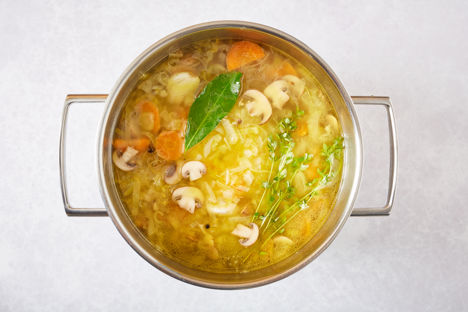Stocks are used as the foundation of many dishes and making your own is a simple process that will improve your cooking immeasurably. Though meaty stocks often take a long time to make, vegetable stocks are usually a lot quicker to prepare and, if made correctly, easily match their depth of flavour.
There are two basic types of vegetable stock; white or brown. White vegetable stocks are typically colourless and milder and fresher in taste, adding a subtle flavour to dishes. These are made by simply adding the vegetables raw into a pot with water and simmering. White stocks also tend to be healthier, as no fat is used to cook the vegetables.
Brown vegetable stocks are richer and deeper in colour, adding a more robust flavour to dishes. This is achieved by roasting the vegetables, often in butter until nice and caramelised, before simmering them in water.
For a nice rounded vegetable stock base, begin with onion, garlic, celery, leek, carrot and mushrooms. The standard aromatics are bay leaves, peppercorns, thyme and parsley stalks. You can then add other vegetables, herbs or spices to flavour your stock however you wish.
Consider turnip or celeriac for an earthier taste, butternut squash or pumpkin peel for sweeter notes or fennel, star anise and some dill or tarragon for a stock with a pleasant aniseed flavour.
For a fresh, light stock, use a white stock base and add peas, the woody asparagus ends (which would normally be discarded) and some shredded cabbage for the last ten minutes. It is important greens aren't added until the end otherwise it will give the stock a sulphurous flavour (think over-boiled cabbage).
If you want a deep and intense stock, use a brown stock base and add umami-rich ingredients such as dried mushrooms, tomato purée and seaweed. Adding slices of fresh ginger, chilli and lemongrass to a white vegetable stock will give you an aromatic, Southeast Asian-style stock.
Steer clear of any member of the brassica family; broccoli, cauliflower, kale and cabbage among others. These will ruin your stock with a sulphurous and bitter flavour. Softer vegetables such as potatoes or pumpkin are no good as they break down too easily, creating a cloudy stock. If adding fresh tomatoes, remove the seeds as they can impart a bitter taste.
The fresher the vegetables you use for stock, the better the flavour will be. Having said that, it is fine to collect peel and trimmings to add to the pot for extra flavour in favour of them going in the bin – just ensure they have been cleaned. A little potato peel, for example, can give stock a bit of body.
All the vegetables you use should be chopped finely, as this creates a larger surface area for caramelisation (when making brown stock) and means more of the vegetable will be exposed to water while simmering (which is important for white stock). For brown vegetable stock, sweating the vegetables down in butter adds a nice richness, but feel free to just use olive oil if you want to keep the stock vegan or healthier.
As a rule, add an equal amount of water to the weight of the vegetables, or pour water into the pan until the vegetables are fully submerged but covered by no more than a few centimetres. Always add cold water, as the process of bringing it to the boil with the vegetables already in it helps bring the impurities to the top.
Be careful when seasoning stock – if you intend on reducing it down for a sauce do not add any salt until right at the end, as the saltiness will intensify and may become overpowering. If you're using the stock straight away without reducing, however, season as normal.
The recipe below makes 1l of basic brown vegetable stock. If you want to make a white vegetable stock, skip the first few steps and simply add everything to the pan with the water (omitting the oil and butter).
Metric
Imperial
- 1 tbsp of olive oil
- 2 tbsp of butter, (omit if making a vegan stock)
- 1 onion, finely sliced
- 1 leek, white part only, finely sliced
- 1 celery stick, finely sliced
- 200g of button mushrooms, finely sliced
- 1 carrot, finely sliced
- 1 bulb of garlic, halved horizontally
- 150ml of white wine, (optional)
- 2 bay leaves, fresh or dried
- 4 sprigs of thyme
- 1/2 tsp black peppercorns, lightly crushed
How to use vegetable stock in cooking
Vegetable stock is a very versatile product and it is handy to have some kept in the freezer, readily available to enhance any meal. Foods which may usually be cooked in water such as rice, couscous or dried beans are tastier cooked in stock. It is a great base to any soup, stew or curry, and of course is essential for any vegetarian risotto.
Get in touch
Please sign in or register to send a comment to Great British Chefs.

